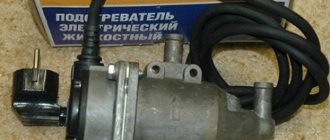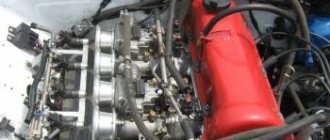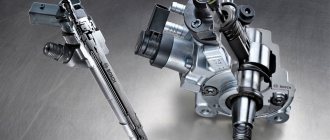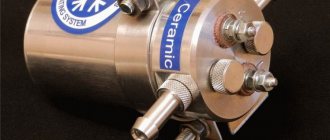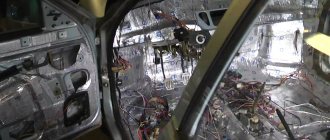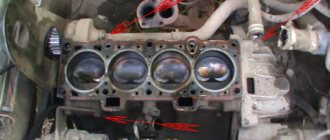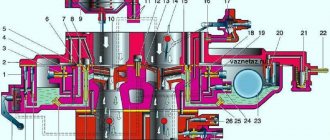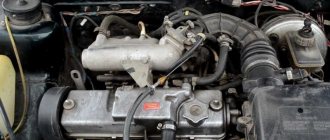In winter, starting a frozen power plant causes many problems for car owners. Thickened oil, poor fuel volatility, and increased resistance in the battery make the power unit very reluctant to start. But there is a solution to this problem - install and use pre-heaters. These devices allow you to warm up engine fluids, providing relatively easy engine starting in severe frost.
The car accessories market offers a large number of such devices. But many car owners are in no hurry to spend money, preferring to make an engine heater with their own hands. And this is quite possible; in terms of performance indicators, homemade devices are not inferior to factory ones, and the financial costs will be significantly lower.
In general, factory-made and home-made products use the same principle. Heating elements are used for heating, that is, heating is carried out by electricity, but they can affect both antifreeze and oil. They can also operate from a 220 V network, or be autonomous, powered by the car’s on-board network (12 V). Each of these devices has its own advantages and disadvantages.
DIY engine heater
An engine heater is necessary for every car in order to start without problems in any frosty winter. You can buy a factory heater and install it on your car, but if you don’t have enough money for a factory one or you want to make an engine heater yourself, you will need special skills and materials. In order to make a good heater with your own hands, you will need the following components. 12 mm gun casing, glow plug, relay, copper wires and this will probably be enough. First of all, you will need to drill a hole in the side wall of the sleeve; you will also need to make a hole in the bottom in which the thread for the candle will be cut. After which the sleeve is attached to the suction pipe. This design is installed in the car tank and a wire with a voltage of 12 volts is supplied to it. The operation of such a homemade heater is that voltage is applied to the spark plug installed in the sleeve, which gradually heats it up, and the spark plug itself already heats the fuel in the car tank, which is supplied to sleeve through the suction pipe. After installing such a system, you don’t have to worry about your car not starting at low temperatures. Now you can start your car in any case, even if the temperature outside is below 30 degrees below zero. If the temperature is not very low, try to start your car without turning on this system, since with frequent use and at not very low temperatures it may break down. To protect this system, felt materials are used, which are placed on the manufactured structure. Before starting a homemade heater, you need to check it very carefully; it must work very clearly and accurately. This heater cannot be used with water; install it only in combination with antifreeze. Carefully check the cooling system; there should be no sediment in it. You can turn on the heater only when the engine is not running, as otherwise a breakdown may occur after which it will be very expensive and time-consuming to restore your engine. In order to avoid making mistakes and causing irreparable damage to your car, follow certain safety rules. If your car has a V-twin engine, then you need to install the heater on both sides, this will allow the heater to work more efficiently and will allow your car to start faster even at the lowest temperatures. With a careful approach and proper execution of all work on the manufacture of an engine heater, you will be able to make a high-quality and reliable heating system with your own hands, and it, in turn, will give you the opportunity to start your car without problems in any weather. When installing the system, be very careful and careful, this will allow you to avoid making any mistakes.
Fuel filter heater for diesel engine separator configuration
It is important to know
To manufacture a fuel filter heater for a separator configuration of a diesel engine, you will need a lathe.
Before installation, it should also be taken into account that the drain unit in diesel engines is used to remove liquid from the sump. Accordingly, if this device is to be removed, it is necessary to use only proven high-quality fuel.
What will you need?
Tools and materials required for installation:
- set of wrenches;
- a piece of metal pipe for making a bushing;
- wires for connection;
- a lathe that will be used to cut threads.
Algorithm of actions
You can install a diesel fuel filter heater of a separator configuration as follows:
- A metal sleeve of the required size is made. The outer circuit of the device must match the drain valve of the system.
- Using a drill, drill a central hole.
- Internal and external threads are cut. The outer pitch should correspond to the drain element, and the inner pitch should correspond to the thread for the glow plugs.
- The completed structure is assembled from candles. The resulting mechanism is screwed into the body of the separator device. The shape of the part itself needs to be corrected - a pin should be made on the hexagon. To do this, a screw or bolt is welded on the side.
- After installation, the wiring is laid. On the positive line you need to install a switch button and a four-pin relay. The entire electrical circuit must be protected by a safety device to prevent voltage surges and short circuits.
- After installation, it remains to connect two terminals. Grounding or “ground” goes to the bushing, and the positive contact must be connected to the glow plug. The installed device is being tested.
Video: features of the use of fuel heaters
Roman Romanov in his video spoke about the nuances of using heating devices for fuel filters of separator design.
How to install and connect an engine heater yourself
Do-it-yourself oil pre-heater
Heaters (with the exception of those that operate on the principle of natural circulation of liquid) are connected to a break in the lower (return) hose of the heater. Connecting to the top (supply) hose is not only less efficient, but may damage the heater. The reason for this is the low level of coolant in the cylinder head. For the heater, it is necessary to prepare a mount that will allow it to be clearly fixed. There should be free space around the heater, this will protect the body from damage while driving on uneven roads. All electrical wires must be laid by tying them into a single bundle and attaching it to the engine and body using clamps that are sold at any auto store. This will avoid chafing or broken wires. To connect the autonomous heater to the fuel tank, you will have to lay a separate fuel line. This will avoid serious interference with the operation of the vehicle's fuel system, and will also ensure that the heater operates if the fuel pump located in the tank is turned off.
- Roll the car onto a pit or lift and carefully inspect the engine compartment. Find and equip a place to install the heater. Put it there, but don't plug it in. Make sure the fuel line, wires and hoses fit properly and are not in contact with other parts.
- Then check and replace the thermostat if necessary. If you do not do this, the heated coolant will circulate not through the inner circle (cylinder block, cylinder head, heater), but through the outer circle (inner circle + radiator). Because of this, the efficiency of the heater will decrease several times. If you are installing an autonomous heater, first lay the fuel line. Make sure that it will not be damaged when the bottom of the car hits an unexpected bump. Make sure the connection to the fuel tank is tight.
- Drain the coolant. If it was not possible to locate the heater next to the lower hose of the heater, then prepare a hose of a suitable internal diameter (on most cars it is 16 mm). Unscrew the heater hose clamps and remove it.
- Prepare sections of suitable length from the engine to the heater and from it to the stove. Install them and secure with clamps.
- Connect and route all wires through the engine compartment. After this, fill the cooling system with antifreeze or antifreeze (take into account the increased volume of the system), start the engine and make sure that there are no leaks anywhere. And only then connect the fuel line. After connecting it, apply power to the fuel pump and make sure that no fuel leaks appear anywhere within 15 minutes.
Severs-M installation
One of the most popular of them is Severs-M. To install on a car you will need:
- Rubber hose, diameter 16 mm
- Two tees: the first is 32*16, and the second is smaller - 16*16
- Two clamps 30*40 and six clamps 12*20
- Sealant and 5 liters of antifreeze
Since this device is an electrical type, it is necessary to determine in advance the length of the cable and where the 220V outlet is located. It is better to install it under the air filter, and heat it through the stove. The antifreeze intake is from the pipe between the radiator and the stove.
- To get started, you need to drain the coolant and cut the hoses and pipes
- Then install the tees, lubricating them with sealant in advance
- We attach hoses to the tees and tighten everything with clamps
- After this, you need to pour liquid into the cooling system, wait a little until the air comes out, start the car and add liquid
- If after a visual inspection there are no drips at the joints, it means that the installation was successful and heating will be
- The power cord must be secured to the body so that it does not come into contact with heating or moving parts of the machine.
Autonomous
DIY car blanket dimensions, materials and sewing method
Heaters that operate autonomously from external power sources are, in turn, divided into air and liquid. The first ones serve to access the warm flow into the cabin, but the second ones only serve to heat the engine.
You can read separate articles on this topic:
- Webasto engine preheater;
- Eberspacher engine preheater;
- BINAR engine pre-heater.
Their installation is much more complicated than installing a “modified boiler”, but there are also many more functions. Thus, heaters of these types are usually equipped with remote-controlled key fobs, or can be in contact with mobile gadgets. The price for such “goodies” is also appropriate.
A distinctive feature of autonomous preheaters is the ability to install them in the place where it is convenient. Essentially, these are modified internal combustion engines that have their own fuel and water pumps, glow plug, combustion chamber and sensors.
On the other hand, one can understand car enthusiasts who are trying to save money and do what they can do themselves. This is evidenced by numerous videos on the Internet, where car enthusiasts share their experiences.
Heater: brew yourself
When choosing a preheater, you need to take into account the design of the engine, how often you operate it in cold weather and, of course, the cost. The price of a normal pre-heater is about 8,000 rubles, and the weight is about 8 kg, but you can make an engine pre-heater yourself.
In order for the engine to start without problems, it is necessary to heat the oil in the crater. It’s dangerous to do this with open fire, but here’s what you can come up with:
- Take a pipe bent in two places and in different planes (or weld it yourself)
- Weld 3 legs to it for stability and place a nozzle under it
- Since there is no longer an open fire due to the bend, and heating is on, you can place the structure under the crankcase and after 20 minutes, you can drive even in severe frost
It’s a good idea to carry such a device with you at all times, especially for those who like winter fishing and hunting. Nowadays there is a large selection of modern devices of similar action on sale.
How to make a preheater with your own hands instructions.
DIY car engine cleaning products
First we need a standard tee for an inch pipe. It is necessary to wrap a heating element into one of the ends of such a tee, which, by the way, can be picked up in the same plumbing store where you will purchase the tee. If the seller finds it difficult to help you with your choice and purchase, then the words “TEN for instantaneous water heaters for 1-1.5 kW” should help him offer you what you need. Ideally, it is desirable to find a similar heating element with a built-in thermostat.
A small pipe 10-15 cm long is screwed into the opposite end of the tee, which is necessary so that the coolant in the resulting chamber heats up faster and better.
It is necessary to screw adapter plugs into the remaining unused end of the tee and the end of the pipe opposite the tee, allowing a flexible hose to be connected at this location.
During assembly, all connections must be reliable and tight.
Now, the heating unit is ready, now it needs to be connected to the engine cooling system.
Most often, the best connection location will be a break in the lower hose of the cooling system, which supplies coolant to the car's interior heater.
Next, a wire of the required cross-section for your power is connected to the contacts of the heating element. Subsequently, voltage will be supplied to this wire, which is necessary for the operation of the created system.
The next step in making an engine preheater with your own hands will be to install an electric pump to circulate fluid in the system. For these purposes, you can use ready-made options - pumps for pumping coolant from Gazelle cars, or you can look for something else. It is quite possible that such a pump is in your car itself, then a similar one can be used for our purposes.
When you find the pump, it should be connected in front of the heater we assembled - through a standard open relay to the car's hog network or through a step-down transformer with a rectifier to the same socket (220V) as the heating element of the heater.
The preheater is ready.
The operation of this system is as follows: half an hour to an hour before the trip, we connect our heater to the network (during this time, at an outside temperature of about -25°C, 1.5 kW is able to heat the engine, although not to positive temperatures, but to about zero for sure, and make it easier thereby starting the last one), and before leaving – turn it off.
Video
I recommend reading:
How to polish a windshield with your own hands?
Replacing the cabin filter in Opel Astra.
Antifreeze (antifreeze) is thrown out of the expansion tank - reasons, ways to solve the problem.
Why does the idle speed fluctuate?
How to connect and use a water heater?
Let's consider the procedure for connecting and using homemade heaters.
Solar
The solar collector must be connected to the pool circulation system . The order in which the tubes are connected does not matter much - the installation works equally in both directions.
Electric
The electric heater is connected to the gap in the circulation system, after the filter, but before the dispensers. This is important because chemicals are added to the dispenser to purify the water.
Operation of electric heaters consists of setting the operating mode (switching the power of the heating element, achieving maximum effect). If the device does not work, change the heating element. Other than this, no special arrangements are required.
Fuel (wood)
The wood heater is connected by connecting the coil leads to the circulation system (into the gap).
The heater's operation begins after the combustion chamber is loaded with wood and ignited. While they burn, the water heats up.
If there is no fire, the installation simply passes water through itself. The user is required to regularly clean the firebox from ash, soot, and coals. In addition, you need to monitor the condition of the chimney, check the connections and the walls of the firebox - they can burn out.
Battery powered
This type of heater includes heat accumulators. While the engine is running, the coolant heats up to a temperature of 95-100 degrees and circulates through the engine channels. The heat accumulator is a well-insulated reservoir (vacuum thermos) with a capacity of up to 15 liters, through which the coolant passes before entering the radiator.
Such devices include the popular Gulfstream system, which is produced in modifications for 2.5 and 4 liter engines. The differences between the models are in the volume of the thermos - 10 and 15 liters. This thermos keeps the coolant hot for up to 2 days. After power is supplied to the electric motor, hot liquid begins to circulate through the cooling system, heating the engine. The engine warm-up time takes 5-15 minutes depending on the air temperature.
In addition to the heat accumulator, stores sell various devices that, according to the manufacturer, heat the oil and make it easier to start a cold engine. But in reality, the only effect from these devices is a completely dead battery, which is unable to crank the engine shaft. The reasons for this are obvious - it is necessary to warm up not only the oil, but also the coolant, and this requires a lot of energy. Battery life is not infinite. To warm up the engine to normal temperature, 0.5-1 kWh of energy is required. At a voltage of 12 volts, this will require from 40 to 80 Ampere hours. And the capacity of a car battery is 55-75 Ampere hours. As a result, there is no energy left to start the engine.
INSTALLATION ON VEHICLE
We cut the lower hose supplying antifreeze to the car's heater and connect the heat exchanger and the pump from the Gazelle in series into the gap to force the antifreeze to circulate in a small circle. If the pump is not attached to the engine, we connect the “minus” to its housing. When installing the pump, the main thing is not to make a mistake with the direction of the antifreeze flow (there is an arrow on the pump).
We connect one wire to the negative of the battery, and the second through a 7.5-10 A fuse and a switch to the positive. I have an LED connected parallel to the spirals through a resistance of 2 kOhm to visualize the operation of the device. Also, over time, I installed a time relay in the “+” wire gap for 30 minutes (photo 11), so as not to drain the battery in vain. On the side of the car’s center console I installed toggle switches for turning on the antifreeze heating (photo 12).
When, after a long stay in the cold, I need to start the car, I turn on the heater for 20 minutes, then start the engine and, without turning off the heating, start driving or warm up the engine at idle speed. The needle on the temperature sensor does not rise, but from the way the starter turns, it is clear that the engine is much lighter, and it seems that it starts not at -30°C, but at 0°C.
After the engine is started, with the heater turned on, it warms up approximately 1.5 times faster.
This is how, for a small amount, you get pre-heating of the engine, not tied to a 220 V electrical network.
I use this heater all winter. Frosts reached -35°C, the car started up confidently!
- Main parts of the heat exchanger.
- Two plates are welded inside to increase heat transfer.
- To ensure tightness, all seams are welded with a Kempi welding machine.
- Asbestos sheets were used as electrical insulation.
- Asbestos liners will prevent the coils from shorting to the body.
- Nichrome spiral for some household appliance.
- Heating elements.
- The covers are tightened with 25 mm studs.
- The assembled heat exchanger must be checked for leaks.
- The outside of the heat exchanger is wrapped with foam film for thermal insulation.
- To avoid draining the battery, I connected a time relay.
- The power switches are located on the side of the center console.
12V oil heating
The main condition for do-it-yourself oil heating of the engine is that the device must be in the sump. To do this, there is no need to make additional holes in it, since the design is used instead of a drain plug.
What will you need?
To complete the task you will need:
- small pipe;
- nichrome wire 0.6 mm, length should be 2 meters (you must use the product in the form of a spiral);
- insulators made of ceramics;
- textolite washers and bushings;
- drain plug;
- bolts with nuts (as connecting components).
Algorithm of actions
Step-by-step assembly instructions:
- First, take the drain plug and make a hole in it using a drill. It should not be through; there will be about 5 mm left to the end. The hole diameter should be 13 mm. After this, an M14 thread is cut into it.
- After this, a through hole with a diameter of 8 mm is made. A textolite tube of the required size is installed in it.
- Then take a piece of tube measuring 120 mm, its outer diameter should be 1.4 cm. An M14 external thread must be applied to one part.
- After this, the car owner needs to tighten a long bolt and nut to the nichrome spiral. A textolite washer is installed on it, the product is inserted into the hole of the drain plug. A washer is mounted on the other side, after which the entire structure is secured with a nut. This part will serve as the positive terminal, so you need to make sure that the located screw does not touch the body of the plug.
- Insulators made of ceramic are installed on top of the spiral. A screw with a nut is also screwed on the other side.
- A spiral with insulating elements is installed into the tube. Then the resulting structure is screwed into a threaded hole made in the cork.
- The opposite end of the pipe is capped. At this stage, you need to make sure that the screw at the end of the spiral is always in contact with the plug; for this, the element can be soldered.
- Then the product is sealed. To complete the task, it is recommended to solder the connection point of the pipe.
- After assembly, you need to install and connect the pan heater. The heater is screwed in instead of the standard drain plug, but when the latter is removed, some of the engine fluid will come out of the system. After installing the heating device, the volume of lubricant must be replenished.
- To provide power, you need to lay the cable from the battery. For this, only the positive conductor is used, since the grounding function is performed by the pallet itself. Additionally, a switch and a 10 amp safety device can be added to the circuit.
Heating device diagram
We make a pre-heater for the engine. What do you need to know about it?
It is best for beginners to consider making their own pre-heater using its most basic representative - a device that simply heats up the coolant in the engine. True, such a heater requires an outlet near the place where the car is parked overnight. Therefore, let's assume that this requirement does not pose a problem for you. Let's continue.
So, the heater in our case will consist of a heating heating element, which will cut into a small circle of the cooling system, and a pump that forces the coolant to circulate through this system when the engine is turned off.
In addition to the heating element, the heater itself will require some fittings, pipes and fittings. It will consist of and with their help and be connected to the motor cooling system. Now the details.
Video: development of a pre-heater for VAZ
Sergey Kalinov in his video spoke in detail about the nuances of self-assembly of heating systems and showed an example of their installation on VAZ cars.
Most car owners, when they mention winterizing their car, remember replacing tires, buying a new battery, or other activities that help them get through the winter comfortably. And many of them are right, especially those living in less harsh parts of Russia, where the temperature very rarely drops below 10 degrees below zero. But in severe winters, when the temperature can easily stay at -30 degrees Celsius for weeks, you have to prepare your car for winter more carefully, or forget about its existence until the first spring thaw.
For this purpose, there is a special device called engine preheating. This device allows you to quickly and economically warm up the engine and interior of the car; in some trim levels there is control using a timer, remote control or mobile application for smartphones on the Android or iOS operating system. To warm up the car, gasoline or electricity can be used, it depends on the configuration and model of the device.
It is worth noting that many may find that making a preheater themselves can be incredibly difficult. But actually. You will need to put in very little effort to assemble the structure and connect it to the car system. But before the actual instructions for making preheating, we will understand the principle of operation and the history of creation.
Also, for those who want to understand in detail the factory device from the German company WEBASTO, you can read our article, which describes in detail all the nuances of the device from this manufacturer - All about WEBASTO.
How did the idea of creating preheating come about?
But more often, more “progressive” methods were used, or rather, blowtorches or kerosene lamps were used. But it’s even difficult to imagine a modern person digging under a car with a blowtorch in -30 degree frost. Therefore, the emergence of automatic systems that warm up the engine and interior of the car is a logical step in developing the comfort of car owners.
Types of pre-heaters
First of all, the main task of preheaters is to ensure that the coolant in the vehicle system is heated to operating temperature. Thereby warming up the power unit and allowing it to start in any weather conditions. At the same time, fuel is significantly saved on warming up and the working life of the engine itself is preserved. After all, the motor constantly starts and runs at operating temperature, excluding operation with increased load at low temperatures.
Note that preheaters can be divided into only three main groups, and all of them differ only in the type of fuel or energy used. But all the main functions and the heating principle remain the same. And so, devices are divided into:
• Gas (in design very similar to gasoline).
Below we will consider each type separately, where we will discuss the positive and negative aspects of different types of devices, as well as the power and heating speed.
Electric pre-heater
But such simplicity also brings with it some difficulties. The car becomes dependent on an electrical outlet, and if there is no automation, then overnight, the pre-heater can consume about 15 kW of electricity.
Therefore, such a system can be installed, at least having your own garage with electricity. In other cases, it is worth paying attention to devices of a different configuration.
Gas or petrol pre-heater
Accordingly, the car can be left parked even at -50 degrees Celsius, and by setting the automatic start of heating, you can end up with a warmed-up car with a warm interior.
As disadvantages of use, we can highlight some difficulty in operation and additional fuel costs. And also the need to constantly monitor the condition of the battery, because this system can completely discharge the car’s battery if it is already in poor or almost discharged condition.
DIY preheater design
Before starting the instructions, I would like to note that at home it is not possible to make a device that runs on gas, gasoline or diesel fuel. For independent creation and connection, only an electric model with an external power source is suitable.
Electric engine heaters
The first electric heaters appeared on the streets of Scandinavian cities about 20 years ago. Russian newspapers and magazines then wrote about these units as wonders. Over time (or due to a decrease in winter air temperatures in Europe), the devices began to find use in other countries.
The operating principle of an electric engine heater is quite simple: the device itself is attached to the cylinder block, which is connected via a wire to an external 220 V outlet. Its power is small, but it is enough for efficient operation. Some types of such units are also adapted to heat the interior of the car with a certain amount of heat.
Video - electric pre-heater SEVERS M:
In addition to heaters connected to a remote socket, there are types that receive energy from devices that supply electricity to the car itself.
Each of them has its own advantages and disadvantages. The first is good because it doesn’t “eat up” battery power, but it does cause problems with finding sockets. The remarkable thing about the second is that it operates regardless of the presence of wires, but consumes the current that is generated for automotive equipment.
Well, now the very “root” of what we are talking about here. What is a pre-start electric engine heater? If you have ever seen a boiler, then it will immediately become clear to you what the principle of operation of this thing is. Only instead of a glass, it is inserted into the hole in the cylinder block, usually blocked by a plug, and heats up antifreeze, not water.
The only difference from a boiler is that this device is equipped with a timer or thermostat to turn off the heating when the coolant reaches a certain degree of heating.
How to make a 220V antifreeze heater
To ensure the circulation of refrigerant through the system when developing a 220 V automobile electric engine heater, it is best to use a pump. If there is no pumping device, heating equipment must be installed at the lowest point of the cooling system.
What will you need?
To develop an electric heater for a gasoline or diesel engine you will need:
- metal cauldron or barrel;
- distribution unit (the box can be purchased at an electronics store or at a radio market);
- heating component (for example, a heating element from a kettle);
- fittings for connection (use of plumbing products is allowed).
Algorithm of actions
| Image | Step |
| At the first stage, it is necessary to improve the tank lid; to do this, glass is squeezed out of it. The required shape is cut out of a sheet of textolite (recommended thickness 6 mm), after which the material is glued into the lid using epoxy glue. This will ensure maximum tightness and prevent leakage. | |
| Two fittings are installed at the bottom of the tank | |
| Then a heating component is glued into the lid using epoxy glue, in this case it is a heating element from an electric kettle | |
| The distribution mechanism is installed in such a way that the electrical wiring can be covered in it. Then a socket for connecting the conductor is installed in the lid of the box. | |
| This is what the completed tank and lid look like | |
| The tank is fixed using clamps. One of the fastening elements will not allow the cover to fly off due to pressure when the power unit is running. | |
| A fitting with a valve is installed, which is used to bleed air from the tank |
